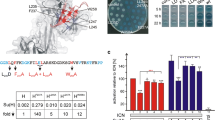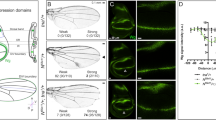Abstract
The phenotypic expression of several mutations in thecut locus ofDrosophila melanogaster is modified by mutations in thezeste, e(y)2 ande(y)3 genes and in some genes of thePolycomb group. All tested sensitivecut mutations have a partially inactivated cut wing enhancer.e(y)3 ul, zv77h andSu(z)2 5 mutations enhance, whilee(y)2 ul, zOp6, Psc1, Su(z)301, Su(z)302 andScm D1 mutations suppress the ct mutant phenotype. The results are discussed in terms of the role of long-distance interactions and DNA compaction in transcriptional control of thecut locus.
Similar content being viewed by others
References
Benson M, Pirrotta V (1987) The product of theDrosophila zeste gene binds to specific DNA sequences inwhite andUbx. EMBO J 16:1387–1392
Benson M, Pirrotta V (1988) TheDrosophila zeste gene protein binds cooperatively to sites in many gene regulatory regions: implications for transvection and gene regulation. EMBO J 7:3907–3915
Bickel S, Pirrotta V (1990) Self-association of theDrosophila zeste protein is responsible for transvection effects. EMBO J 9:2959–2968
Blochlinger K, Bodmer R, Jan LY, Jan YN (1990) Patterns of expression of Cut, a protein required for external sensory organ development, in wild-type andcut mutantDrosophila embryos. Genes Dev 4:1322–1331
Dorsett D (1990) Potentiation of a polyadenylation site by a downstream protein-DNA interaction. Proc Natl Acad Sci USA 87:4373–4377
Dorsett D (1993) Distance-independent inactivation of an enhancer by the suppressor of Hairy-wing DNA-binding protein ofDrosophila. Genetics 134:1135–1144
Franke A, DeCamillis M, Zink D, Cheng N, Brock H, Paro R (1992)Polycomb andpolyhomeotic are constituents of a multimeric protein complex in chromatin ofDrosophila melanogaster. EMBO J 11:2941–2950
Georgiev PG (1994) Identification of mutations in three genes that interact withzeste in the control ofwhite gene expression inDrosophila melanogaster. Genetics 138:733–739
Georgiev PG, Corces VG (1995) The Su(Hw) protein bound togypsy sequences in one chromosome can repress enhancer-promoter interactions in the paired gene located in the other homolog. Proc Natl Acad Sci USA 92:5184–5188
Georgiev PG, Gerasimova TI (1989) Novel genes influencing the expression of theyellow locus and mdg4 (gypsy) inDrosophila melanogaster. Mol Gen Genet 220:121–126
Geyer PK, Corces VG (1992) DNA position-specific repression of transcription by aDrosophila zinc finger protein. Genes Dev 6:1865–1873
Geyer PK, Green MM, Corces VG (1990) Tissue-specific transcriptional enhancers may act in trans on the gene located in the homologous chromosome: the molecular basis of transvection inDrosophila. EMBO J 9:2247–2256
Hartenstein V, Posakony JW (1989) Development of adult sensilla on the wing and notum ofDrosophila melanogaster. Development 107:389–405
Holdridge C, Dorsett D (1991) Repression ofhsp70 heat shock gene ranscription by the suppressor of Hairy-wing protein ofDrosophila melanogaster. Mol Cell Biol 11:1894–1900
Hoover KK, Gerasimova TI, Chien AJ, Corces VG (1992) Dominant effects ofsuppressor of Hairy-wing mutations ongypsy-induced alleles offorked andcut inDrosophila melanogaster. Genetics 132:691–697
Jack JW (1985) Molecular organization of thecut locus ofDrosophila melanogaster. Cell 42:869–876
Jack J, Dorsett D, DeLotto Y, Liu S (1991) Expression of thecut locus in theDrosophila wing margin is required for cell type specification and is regulated by a distant enhancer. Development 113:735–747
Johnson TK, Judd BH (1979) Analysis of thecut locus ofDrosophila melanogaster. Genetics 92:485–502
Jürgens G (1985) A group of genes controlling the spatial expression of theBithorax Complex inDrosophila. Nature 316:153–155
Lindsley DL, Zimm GG (1992) The genome ofDrosophila melanogaster. Academic Press, New York
Liu S, McCleod E, Jack J (1991) Four distinct regulatory regions of thecut locus and their effect on cell type specification inDrosophila. Genetics 127:151–159
Mazo AM, Mizrokhi LJ, Karavanov AA, Sedkov YA, Krichevskaya AA, Ilyin YV (1989) Suppression inDrosophila: su(Hw) andsu(f) gene products interact with a region ofgypsy (mdg4) regulating its transcriptional activity. EMBO J 8:903–911
Modolell J, Bender W, Meselson M (1983)Drosophila melanogaster mutations suppressible by thesuppressor of Hairy-wing are insertions of a 7.3-kilobase mobile element. Proc Natl Acad Sci USA 80:1678–1682
Mogila VA, Ladvishenko AB, Simonova OB, Gerasimova TI (1992) Intragenic suppression:Stalker, a retrovirus-like transposable element, can compensate a deficiency at thecut locus ofDrosophila melanogaster. Genetica 86:305–311
Pirrotta V (1990) Transvection and long-distance gene regulation. BioEssays 12:409–413
Pirrotta V, Rastelli L (1994)white gene expression, repressive chromatin domains and homeotic gene regulation inDrosophila. BioEssays 16:549–556
Pirrotta V, Manet E, Harbon E, Bickel SE, Benson M (1987) Structure and sequence of theDrosophila zeste gene. EMBO J 6:791–799
Rastelli L, Chan C-S, Pirrotta V (1993) Related chromosome binding sites for zeste, suppressors of zeste and Polycomb Group proteins inDrosophila and their dependence on Enhancer of zeste function. EMBO J 12:1513–1522
Santamaria P, Garcia-Bellido A (1975) Developmental biology of two wing scalloping mutants,ct andBx, ofDrosophila melanogaster. Wilhelm Roux's Arch Dev Biol 178:233–245
Spana C, Corces VG (1990) DNA bending is a determinant of binding specificity for aDrosophila zinc finger protein. Genes Dev 4:1505–1515
Tchurikov NA, Gerasimova TI, Johnson TK, Barbakar NI, Kenzior AL, Georgiev GP (1989) Mobile elements and transposition events in thecut locus ofDrosophila melanogaster. Mol Gen Genet 219:241–248
Author information
Authors and Affiliations
Additional information
Communicated by E. K. F. Bautz
Rights and permissions
About this article
Cite this article
Melnikova, L., Kulikov, A., Georgiev, P. et al. Interactions betweencut wing mutations and mutations inzeste, and theenhancer of yellow andPolycomb group genes ofDrosophila melanogaster . Molec. Gen. Genet. 252, 230–236 (1996). https://doi.org/10.1007/BF02173768
Received:
Accepted:
Issue Date:
DOI: https://doi.org/10.1007/BF02173768




